Computational intelligence and the healthcare system
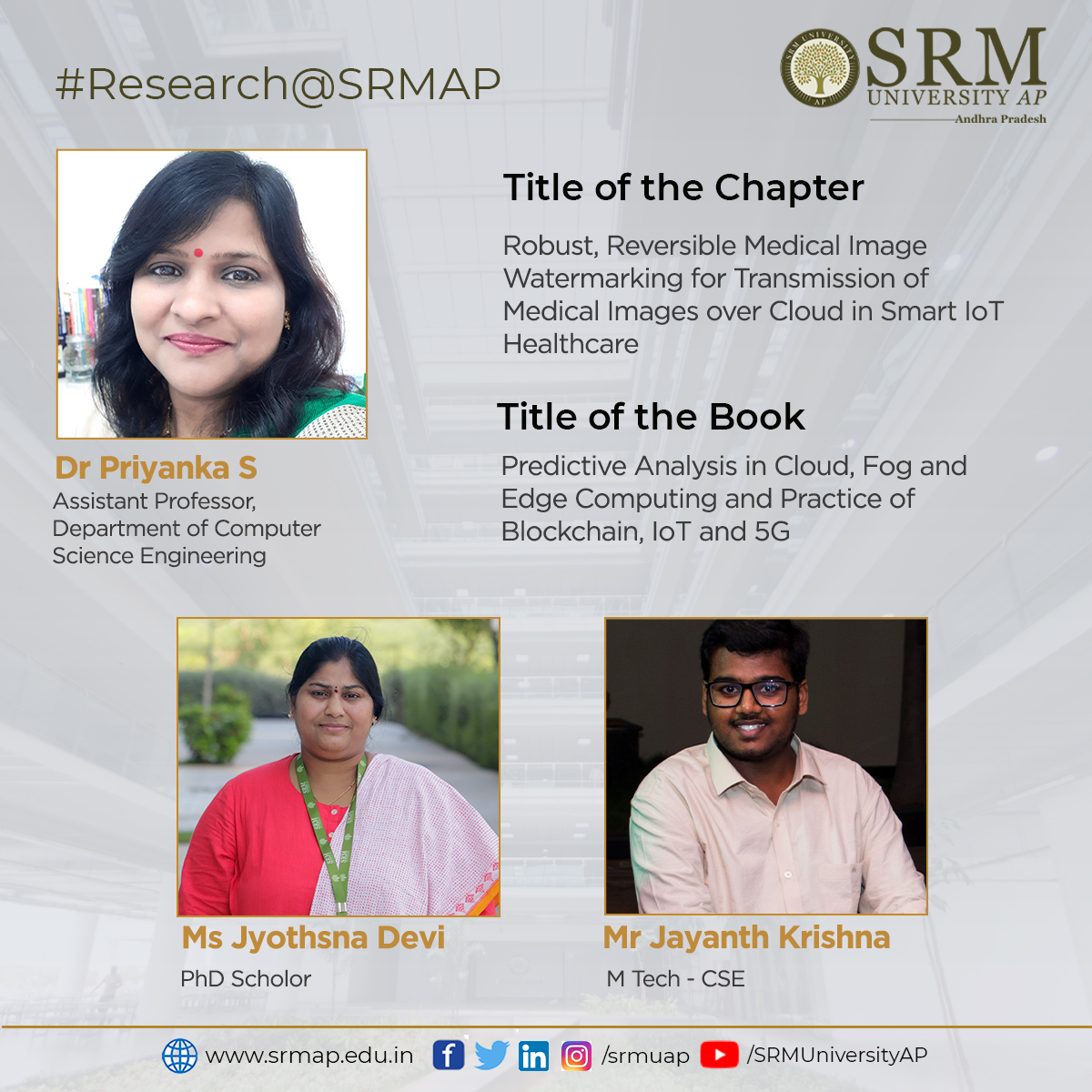 Computational and artificial intelligence is enjoying an unparalleled relevance in the modern world. They improve people’s lives and are highly anticipated in the healthcare industry. Research in this domain is hugely appreciated by the contemporary world, considering its potential to create revolutionary changes in the health care system. The Department of Computer Science and Engineering is delighted to inform you that the paper Robust, Reversible Medical Image Watermarking for Transmission of Medical Images over Cloud in Smart IoT Healthcare has been accepted for publishing as a chapter in the book Predictive Analysis in Cloud, Fog and Edge Computing and Practice of Blockchain, IoT and 5G.
Computational and artificial intelligence is enjoying an unparalleled relevance in the modern world. They improve people’s lives and are highly anticipated in the healthcare industry. Research in this domain is hugely appreciated by the contemporary world, considering its potential to create revolutionary changes in the health care system. The Department of Computer Science and Engineering is delighted to inform you that the paper Robust, Reversible Medical Image Watermarking for Transmission of Medical Images over Cloud in Smart IoT Healthcare has been accepted for publishing as a chapter in the book Predictive Analysis in Cloud, Fog and Edge Computing and Practice of Blockchain, IoT and 5G.
The paper was submitted by Assistant Professor Dr Priyanka S, her PhD student Ms Jyothsna Devi, and MTech student Mr Jayant Krishna. The book chapter for the edited book is entitled Predictive Data Security using Ai – Insights and Issues of Blockchain, IoT, and DevOps and is published by Springer Nature. It is a part of the book series, Studies in Computational Intelligence, indexed by SCOPUS.
The book Studies in Computational Intelligence targets to bring together researchers and practitioners in computational intelligence and AI technology, especially those related to the areas of Machine learning, blockchain, multimedia using AI, smart IoT environment and email spam and online surveys, and many more recent emerging fields. The research work mainly provides highly secure, robust medical image transmission over the cloud in a smart IoT healthcare environment to ensure high embedding capacity and integrity.
This book’s target audience comprises professionals and researchers working in the field of computational intelligence and AI for health services in a smart environment. The book will attract Engineers (computer, industrial, software, and others), health care scholars, and information scientists since it caters to their interests.
- Published in CSE NEWS, Departmental News, News, Research News
Two paper presentations at the 4th International Conference on Energy, Power, and Environment
Two research papers from the Department of Computer Science and Engineering were presented at the 4th International Conference on Energy, Power, and Environment held from April 29 to May 1, 2022. Assistance professor V M Manikandan and three BTech students participated in the conference organised by NIT Meghalaya, India. The papers will be published in IEEE Xplore Digital Library (Scopus Indexed).
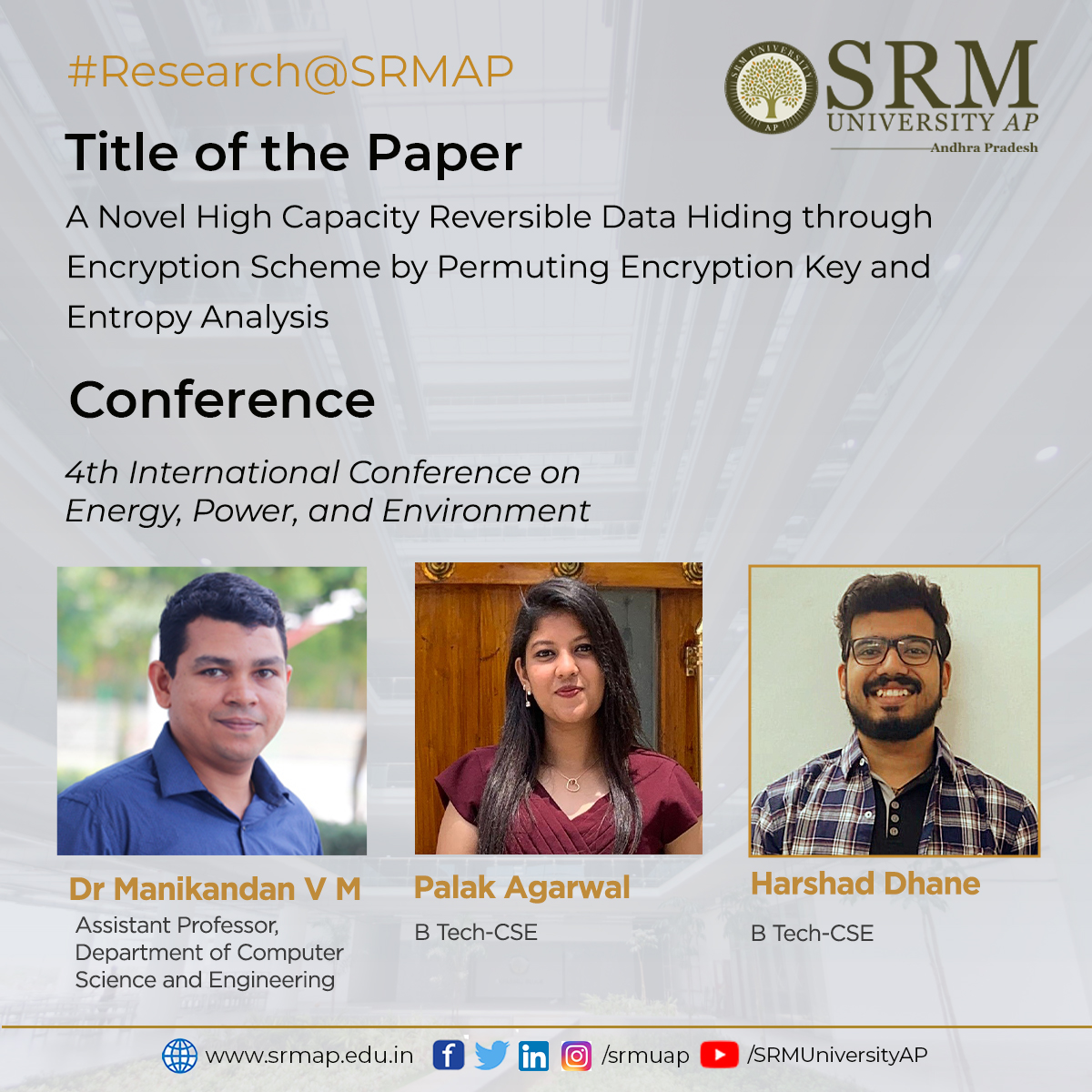 Third-year BTech CSE student Harshad Dhane presented the paper A Novel High Capacity Reversible Data Hiding through Encryption Scheme by Permuting Encryption Key and Entropy Analysis, co-authored by Palak Agarwal, third-year BTech student, and Dr V M Manikandan. The reversible data hiding scheme proposed by the research can be used in the healthcare sector to transmit electronic patient reports along with medical images. Improving the embedding rate of the reversible data hiding is the further plan of the researchers.
Third-year BTech CSE student Harshad Dhane presented the paper A Novel High Capacity Reversible Data Hiding through Encryption Scheme by Permuting Encryption Key and Entropy Analysis, co-authored by Palak Agarwal, third-year BTech student, and Dr V M Manikandan. The reversible data hiding scheme proposed by the research can be used in the healthcare sector to transmit electronic patient reports along with medical images. Improving the embedding rate of the reversible data hiding is the further plan of the researchers.
Explanation of the research
A Reversible Data Hiding Through Encryption (RDTE) scheme will consider an original image and a sequence of bits as the input and generate an encrypted image as the output. This encrypted image will be able to transmit through the network securely, and the authorized receiver can take out the hidden details along with the restoration of the actual image. This paper proposes a new RDTE scheme with a good rate of embedding without any issues during the restoration of the original image. The researchers used the well-known RC4 pseudo-random generator for the image encryption and performed data hiding during block-wise image encryption. In the proposed scheme, the original image is considered non-overlapping blocks of size BXB pixels, and these blocks will be encrypted using a sequence of pseudo-random integers. During the RDTE process, all the possible unique permutations of the encryption key, K, will be generated, say (K0, K1,…, KN). Further, the sender will be capable of embedding one integer value from the set {0, 1, …,N} in a selected image block. A selected block will be encrypted using the pseudo-random sequence of integers using the key K_Q to embed the integer Q in the selected block. The proposed scheme prefers to select keys with unique characters with sufficient length to ensure the maximum embedding capacity. The message extraction and image restoration are performed by analysing the entropy measure from each block after attempting the decryption.
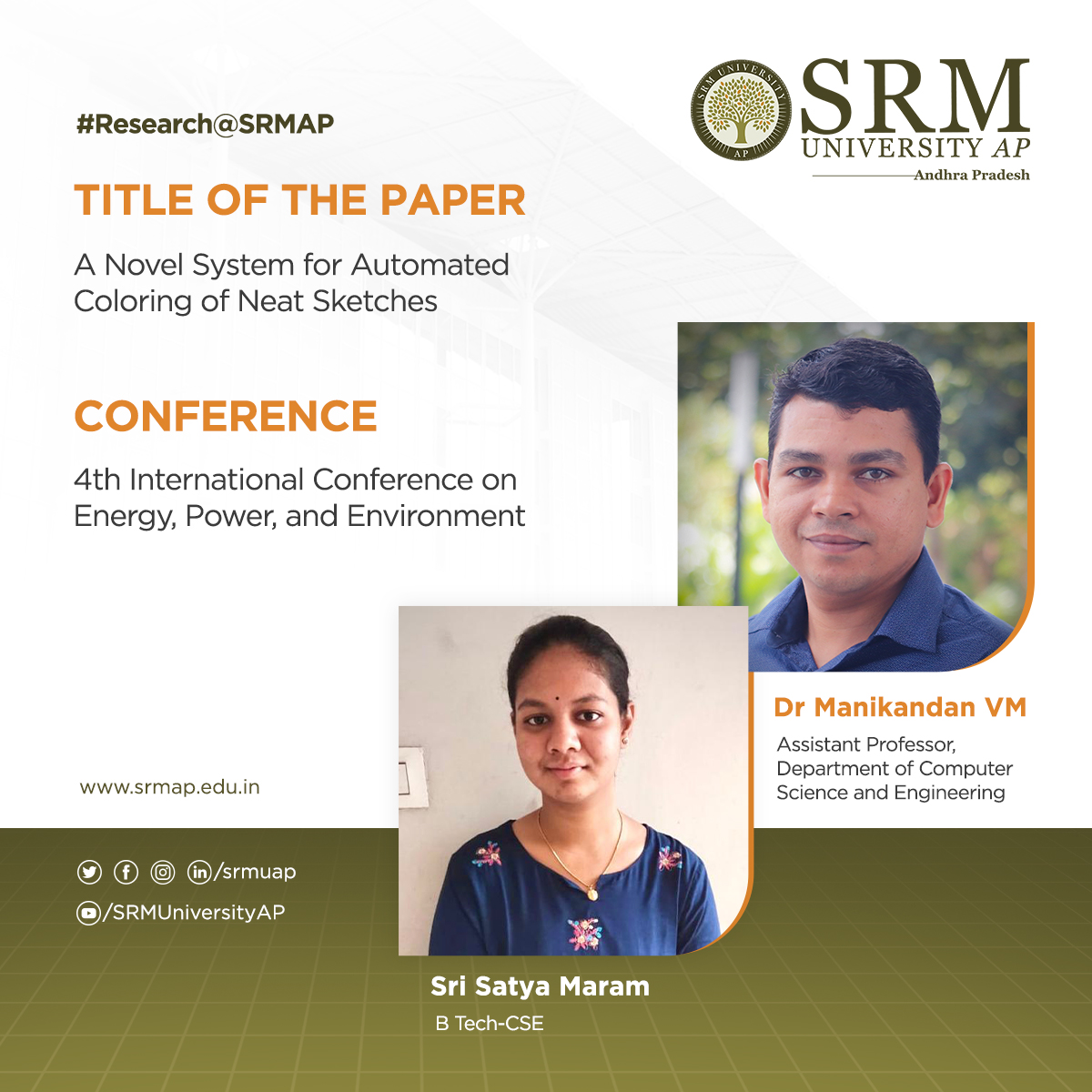 The paper presented by second year BTech CSE student Sri Satya Maram is titled A Novel System for Automated Coloring of Neat Sketches and was co-authored by Dr V M Manikandan. The research introduces a new algorithm to colour a given neat sketch. The proposed algorithm can be used to colour drawings to create animated movies or to colour the designs developed by the designers. The researchers plan to develop artistic features on the coloured image for better visual appearance.
The paper presented by second year BTech CSE student Sri Satya Maram is titled A Novel System for Automated Coloring of Neat Sketches and was co-authored by Dr V M Manikandan. The research introduces a new algorithm to colour a given neat sketch. The proposed algorithm can be used to colour drawings to create animated movies or to colour the designs developed by the designers. The researchers plan to develop artistic features on the coloured image for better visual appearance.
Explanation of the research
The process of colouring neat sketches is a significant activity when making animated movies or for better visualization in computer modelling. The colour filling tools are widely available in almost all the image/video editing software, which will help us pick a colour from a colour palette and can be filled in a selected region. This process is known as flat colouring. The flat colouring process has several challenges. One of the significant challenges is that the colour may leak from the selected regions to neighbouring regions if there are some small openings on the contours. The second concern while using flat colouring is that the designated areas will be filled entirely with the same colour, so the drawing will not have an artistic look. The research proposes a new software application that will take a neat sketch as the input, and the system will generate a coloured drawing as the output. In the proposed scheme, the researchers have converted the given sketch to a grayscale or binary image and applied image dilation operation to fill the small open spaces in the contours (if any). Further, the closed regions are identified and coloured with a predefined set of colours or random colour combinations. While colouring the regions, the proposed system will ensure that the adjacent regions will not be coloured with the same colours. A number of sketches have been considered during the experimental study, and the results are validated manually.
- Published in CSE NEWS, Departmental News, News, Research News
Towards deep learning algorithms for space exploration
Rohan Reddy Sambidi received admission offers with scholarships upto $16,500
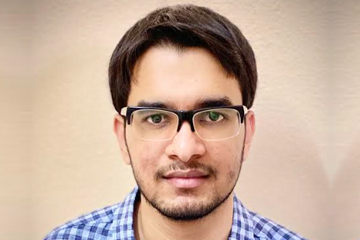 Rohan Reddy Sambidi from Btech CSE at SRM University-AP is delighted to have received admission offers from numerous universities abroad. He secured admission to MS in Computer Science at Purdue University, Fort Wayne; Texas A&M University, College Station (Distance); Arizona State University, Tempe; Illinois Institute of Technology, Chicago; University of South Florida, Tampa; and the University of Houston. Along with this, he received an offer from the University of Maryland, College Park for the Master of Professional Studies in Machine Learning programme. Admission offers came with a scholarship of $10,000 from ASU and $16,500 from IIT Chicago.
Rohan Reddy Sambidi from Btech CSE at SRM University-AP is delighted to have received admission offers from numerous universities abroad. He secured admission to MS in Computer Science at Purdue University, Fort Wayne; Texas A&M University, College Station (Distance); Arizona State University, Tempe; Illinois Institute of Technology, Chicago; University of South Florida, Tampa; and the University of Houston. Along with this, he received an offer from the University of Maryland, College Park for the Master of Professional Studies in Machine Learning programme. Admission offers came with a scholarship of $10,000 from ASU and $16,500 from IIT Chicago.
The suitable choice
Rohan has decided to join the MS in Computer Science programme at Arizona State University. He plans to prepare a thesis and focus his research on the field of machine learning. He wants to explore and address the challenges of designing efficient deep learning algorithms for space exploration through telescopic imagery. He is also interested in doing a few courses on theoretical computer science.
Finding the best
For selecting universities, Rohan started by acquiring a list of reputed universities from the QS Rankings website. Then he shortlisted universities by focusing on the course curriculum, faculty, and resources for student research. He has completed his bachelor’s degree at SRM university-AP with a major in Computer Science and Engineering and a minor in Physics.
Support from SRM AP
The mentorship of accomplished faculty has helped Rohan build strong foundational knowledge in his discipline. Through the course projects, UROP, and the Capstone Project, he has developed research skills and built a compelling profile essential for admission to leading universities in the USA. He expressed his gratitude to his professors and mentors, Prof Dr Ragunathan T, Dr Jatindra Kumar Dash, and Dr Murali Krishna Enduri, for their relentless guidance. He is immensely grateful for the opportunities that he received from SRM university-AP.
- Published in CSE NEWS, Departmental News, News, Students Achievements
Delay-Tolerant IoT enabled smart agriculture system

Agricultural development is one of the powerful tools to boost the economy of any developing country. The recent advancement of IoT-based smart agriculture systems helps to achieve more productivity with relatively less overhead. The Department of Computer Science and Engineering is glad to announce that their faculty; Dr Sobin CC, Associate Professor; Dr Sonam Maurya, Assistant Professor; and Dr Amit Kumar Singh, Assistant Professor; have published a patent titled “Smart Agriculture System using Delay Tolerant Internet of Things” (Application No. 20224102799), a framework for smart agricultural applications using Delay Tolerant Internet of Things (DT-IoT) which can handle the issues related to disruptions in network connectivity.

The inherent limitations of IoT-based smart agriculture systems majorly in terms of resource constraints, frequent network disconnections and vulnerability to many attacks may affect their advantages over the traditional systems. The application using DT-IoT, with access to greater network connectivity can deliver relevant data in real-time. Furthermore, the stored data can be processed and analysed to help farmers in making critical decisions related to their farm filed. Hence, their innovation focuses on designing and developing a prototype for a smart agricultural application using the Internet of Things (IoT).
One of the simplest outcomes of providing smart agricultural solutions for remote villages in India will be greater support to the farmers to improve their productivity and better decision-making in cultivation. But advanced technologies need Internet connectivity in the field to function, which is still a dream in many of the remote villages in India. The lack of proper communication facilities faces off the application of IoT networks. This fact has motivated them to propose a smart agricultural system to work on agricultural application issues using delay-tolerant characteristics. The use of delay-tolerant features in traditional IoT provides a solution for smart agriculture which can handle issues related to disruptions in connection to improve communications.
Another important aspect is that many of the applications, including IoT/Sensor networks, are either simulation-based or experimental. A very few of the applications are developed and implemented in the real-time field for the benefit of farmers in remote villages. In most of the remote villages in India, most of the farmers are poor, many of them are even without primary school education and they rely mostly on traditional agricultural practices which they received from their previous generations. Therefore, their study proposed to test and implement the smart agricultural system with real-time automated solutions related to irrigation, controlled fertilisation, cultivation, production quality, quantity, crop health etc. using IoT with delay-tolerant support. They are also in the process of collaborating with academia and industry to execute this project.
Social Implications
- Proposed smart agriculture system will assist in real-time monitoring of farm field conditions, like irrigation, soil quality, and nutrient deficiency.
- It provides support to farmers to improve their productivity and decision-making in crop cultivation.
- The proposed system will provide optimization in terms of seed selection, resource utilisation, planning cultivation, marketing, harvest quality, etc., using Machine Learning techniques.
- Agricultural field data analysis (for data collected by the large group of sensors) and its visualisation.
- Weather prediction (for better planning).
- Price prediction (for better marketing strategies).
Fig 1: Main components of the proposed Smart Agriculture System
Fig 2: Illustration of 3-level architecture implementation in the Smart Agriculture System
- Published in CSE NEWS, Departmental News, News, Research News
Internet of Things – Security and Privacy in Cyber Space
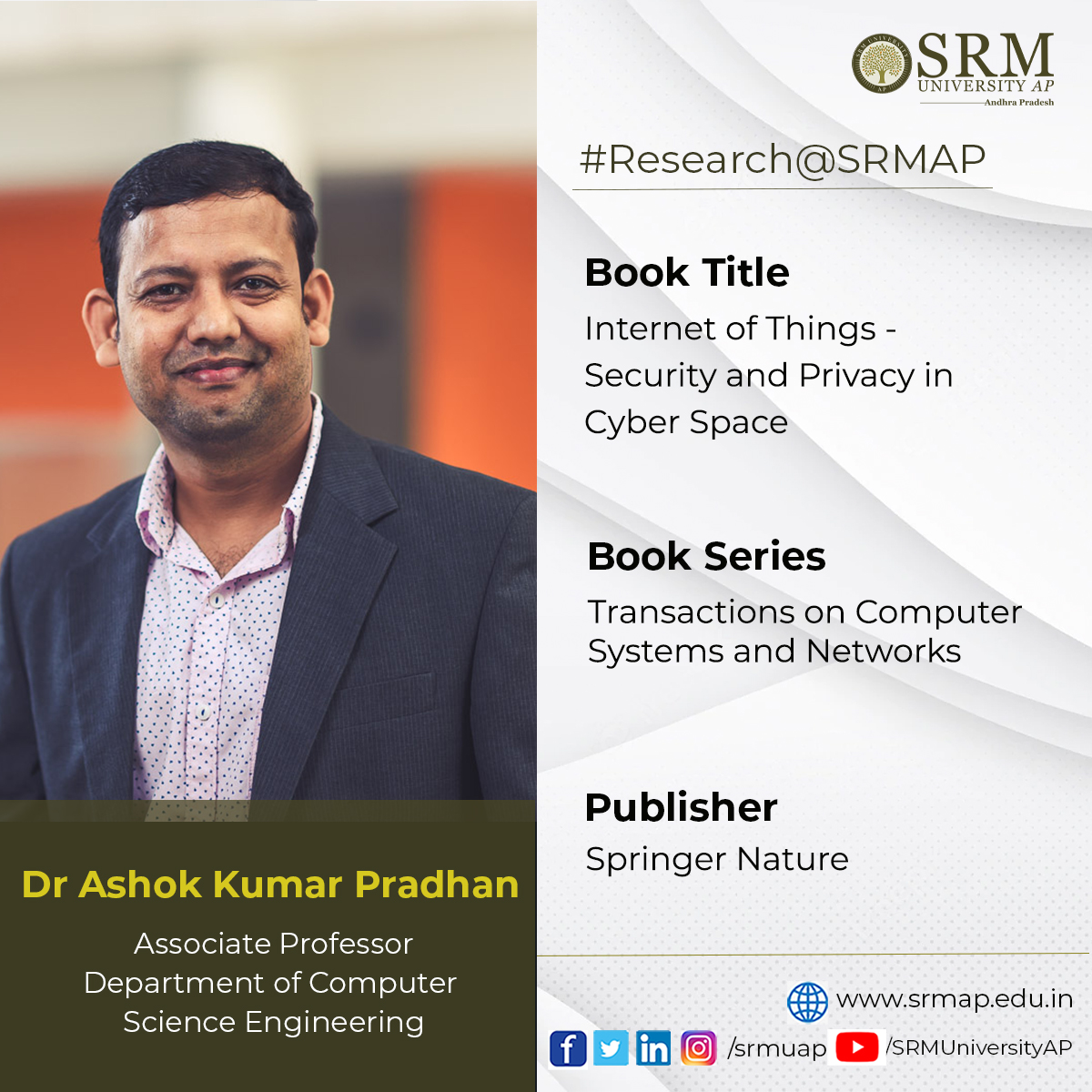 Transactions on Computer Systems and Networks is a unique series that aims to capture advances in the evolution of computer hardware and software systems and progress in computer networks. Associate Professor Dr Ashok Kumar Pradhan, Department of Computer Science and Engineering, becomes a part of this book series by publishing the book titled Internet of Things- Security and Privacy in Cyber Space. Edition 1 of the book was launched on May 27, 2022, under the publishing house Springer Nature. The series aims to present leading works on advances in theory, design, behaviour, and applications in computing systems and networks.
Transactions on Computer Systems and Networks is a unique series that aims to capture advances in the evolution of computer hardware and software systems and progress in computer networks. Associate Professor Dr Ashok Kumar Pradhan, Department of Computer Science and Engineering, becomes a part of this book series by publishing the book titled Internet of Things- Security and Privacy in Cyber Space. Edition 1 of the book was launched on May 27, 2022, under the publishing house Springer Nature. The series aims to present leading works on advances in theory, design, behaviour, and applications in computing systems and networks.
This book covers major areas of device and data security and privacy related to the Internet of Things (IoT). It also provides an overview of lightweight protocols and cryptographic mechanisms to achieve security and privacy in IoT applications. Besides, the book also discusses intrusion detection and firewall mechanisms for IoT. It also covers topics related to embedded security mechanisms and presents suitable malware detection techniques for IoT. The book also contains a unique presentation on heterogeneous device and data management in IoT applications and showcases the major communication-level attacks and defense mechanisms related to IoT.
The book is beneficial for the students who pursue under graduation, post-graduation, and PhD as a reference to get the fundamental as well as research ideas about IoT/ cyber security/ Blockchain technology and their application areas.
- Published in CSE NEWS, Departmental News, News, Research News
Pre-existing health conditions and the risk of Covid-19
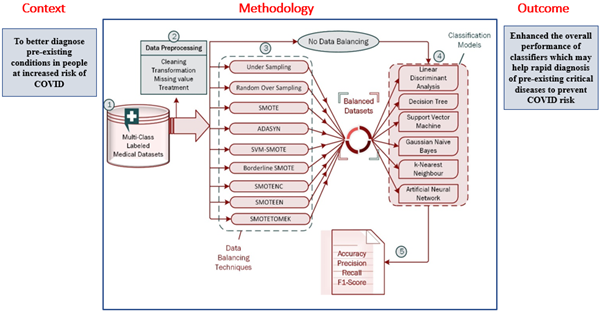 Individuals with pre-existing medical conditions are more vulnerable to Covid-19 and its variants. Patients in countries like India require early testing to diagnose crucial disorders to reduce the risk. Research at the Department of Computer Science and Engineering has come up with a system that automatically identifies and categorises diseases based on the patient’s medical test results. Assistant Professor Dr Ravi Kant Kumar published a paper Improving Performance of Classifiers for Diagnosis of Critical Diseases to Prevent COVID Risk as a co-author in the Q1 journal Computers and Electrical Engineering and has an impact factor of 4.152. With an accurate diagnosis, the required actions can be planned and executed to stop the patients from serious health issues as well as covid risk.
Individuals with pre-existing medical conditions are more vulnerable to Covid-19 and its variants. Patients in countries like India require early testing to diagnose crucial disorders to reduce the risk. Research at the Department of Computer Science and Engineering has come up with a system that automatically identifies and categorises diseases based on the patient’s medical test results. Assistant Professor Dr Ravi Kant Kumar published a paper Improving Performance of Classifiers for Diagnosis of Critical Diseases to Prevent COVID Risk as a co-author in the Q1 journal Computers and Electrical Engineering and has an impact factor of 4.152. With an accurate diagnosis, the required actions can be planned and executed to stop the patients from serious health issues as well as covid risk.
Abstract
The risk of developing COVID-19 and its variants may be higher in those with pre-existing health conditions such as thyroid disease, hepatitis C virus (HCV), breast tissue disease, chronic dermatitis, and other severe infections. As a result, early and precise identification of these disorders is critical. A huge number of patients in nations like India require early and rapid testing as a preventative measure. Machine learning methods for automatically identifying and classifying diseases have been created, and they function effectively when the dataset is well specified and balanced at every class level, including “no disease”. The problem of imbalance arises from the skewed nature of data, in which a large number of cases belonging to one class (known as the majority class) are classified correct, while the other class (known as the minority class) has lesser instances; is unfortunately misclassified by many classifiers. When it comes to human life, this kind of misclassification is unacceptable. To solve the misclassification issue and improve accuracy in such datasets, we applied a variety of data balancing techniques to several machine learning algorithms. The outcomes are encouraging, with a considerable increase in accuracy. As an outcome of these proper diagnoses, we can make plans and take the required actions to stop patients from acquiring serious health issues or viral infections.
Explanation of the research
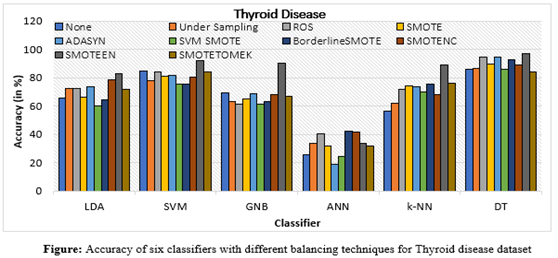 Lethal COVID-19 and its mutant forms may be more likely to arise in patients with pre-existing medical conditions such as thyroid illness, hepatitis C virus (HCV), breast tissue disease, chronic dermatitis, compromised immune systems, obesity, diabetes, heart disease, cancer, etc. For patients, an early and accurate diagnosis of these illnesses is crucial. Based on patient data, machine learning algorithms can assist in the early and quick detection of numerous diseases in a huge population like India. On the other side, machine learning algorithms perform poorly when a dataset has a class unbalanced problem. As a result, we used a variety of smote and its variants in this study to address the problems about the imbalanced class size. The experimental work showed that all six classifiers (DT, SVM, LDA, k-NN, GNB, and ANN) performed better overall on clinical datasets when class balancing strategies and classification techniques were combined. It recommends the use of the recommended classifications and class balancing technique with regard to specific data to identify the disease accurately and automatically
Lethal COVID-19 and its mutant forms may be more likely to arise in patients with pre-existing medical conditions such as thyroid illness, hepatitis C virus (HCV), breast tissue disease, chronic dermatitis, compromised immune systems, obesity, diabetes, heart disease, cancer, etc. For patients, an early and accurate diagnosis of these illnesses is crucial. Based on patient data, machine learning algorithms can assist in the early and quick detection of numerous diseases in a huge population like India. On the other side, machine learning algorithms perform poorly when a dataset has a class unbalanced problem. As a result, we used a variety of smote and its variants in this study to address the problems about the imbalanced class size. The experimental work showed that all six classifiers (DT, SVM, LDA, k-NN, GNB, and ANN) performed better overall on clinical datasets when class balancing strategies and classification techniques were combined. It recommends the use of the recommended classifications and class balancing technique with regard to specific data to identify the disease accurately and automatically
For this work, Dr Ravi Kant Kumar has collaborated with Mr Vinod Kumar, Koneru Lakshmaiah Education Foundation, Vaddeswaram,India, and Mr Gotam Singh Lalotra, University of Jammu, India. Their future research will investigate and design the most effective multi-class balancing method to address the multi-class imbalance problem in medical data.
- Published in CSE NEWS, Departmental News, News, Research News
Sustainable IoT system for freshwater pearl farming
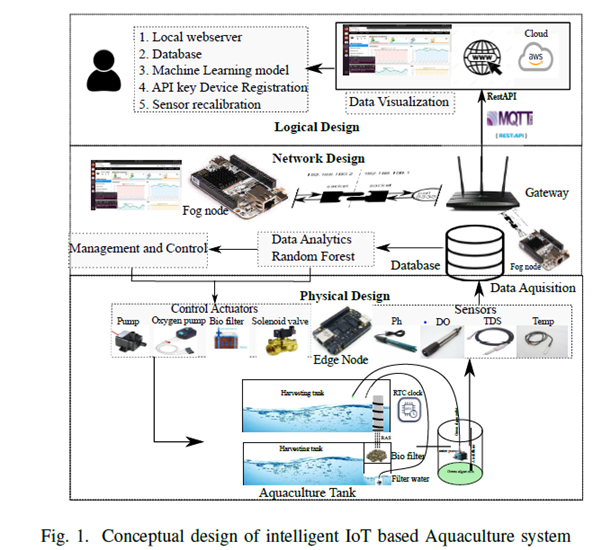
The Department of Computer Science Engineering is glad to announce that Dr Kshira Sagar Sahoo, Assistant Professor, has published an article titled ‘Sustainable IoT Solution for Freshwater Aquaculture Management’ in the Q1 journal, IEEE Sensors, having an Impact Factor of 4.325. The research was published in collaboration with Munesh Singh, from the Department of Computer Science and Engineering, PDPM IIITDM Jabalpur Campus, Madhya Pradesh, and Anand Nayyar, Graduate School, Faculty of Information Technology, Duy Tan University, Vietnam.
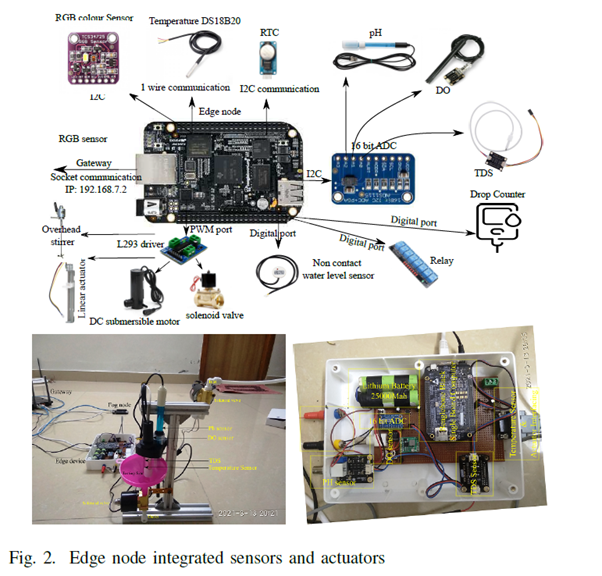 Freshwater pearl farming has the potential to generate an alternative source of income for small farmers. Indian freshwater river bodies have 51 types of species that can produce pearls. Still, India imports 2.4 billion dollars’ worth of pearls from China and Japan. To reduce the import burden on the Indian economy, the government encouraged the farmers to do integrated freshwater pearl farming. Aquaculture-based farming needs a small investment for the initial setup. Although the Indian government promotes aquaculture-based farming through subsidies and free training programs, farmers find it difficult to get success in aquaculture-based farming.
Freshwater pearl farming has the potential to generate an alternative source of income for small farmers. Indian freshwater river bodies have 51 types of species that can produce pearls. Still, India imports 2.4 billion dollars’ worth of pearls from China and Japan. To reduce the import burden on the Indian economy, the government encouraged the farmers to do integrated freshwater pearl farming. Aquaculture-based farming needs a small investment for the initial setup. Although the Indian government promotes aquaculture-based farming through subsidies and free training programs, farmers find it difficult to get success in aquaculture-based farming.
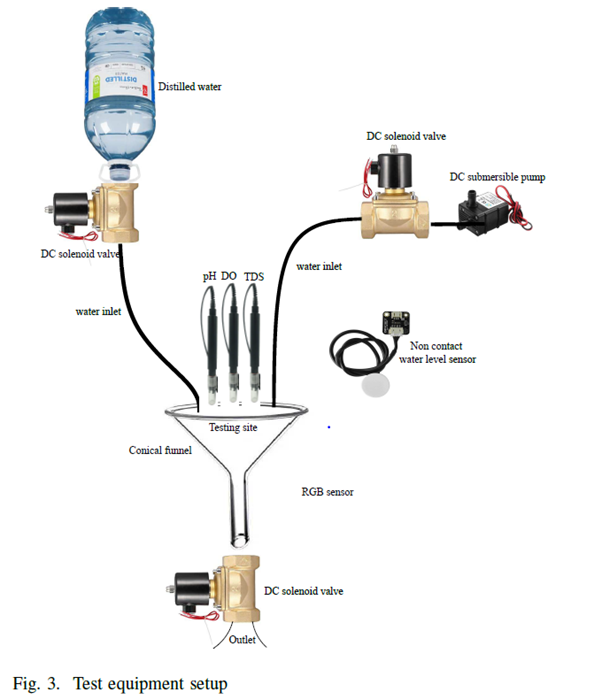 The paper proposes a comprehensive IoT system for freshwater pearl farming which has an intelligent control system for maintaining the aquaculture environment. The proposed system monitors and supports the habitable underwater environments for aquaculture. To train the farmers and educate them in pearl farming business is a time taking and skill-oriented job. The comprehensive IoT system will encourage farmers for freshwater pearl farming and proper utilisation of the government subsidy granted for aqua farming. In future, the researchers will consider more relative water parameters for robust forecast and analyse the best model for predictive analysis.
The paper proposes a comprehensive IoT system for freshwater pearl farming which has an intelligent control system for maintaining the aquaculture environment. The proposed system monitors and supports the habitable underwater environments for aquaculture. To train the farmers and educate them in pearl farming business is a time taking and skill-oriented job. The comprehensive IoT system will encourage farmers for freshwater pearl farming and proper utilisation of the government subsidy granted for aqua farming. In future, the researchers will consider more relative water parameters for robust forecast and analyse the best model for predictive analysis.
Abstract of the Research
In recent years, we have seen the impact of global warming on changing weather patterns. The changing weather patterns have shown a significant effect on the annual rainfall. Due to the lack of annual rainfall, developing countries like India have seen a substantial loss in annual crop production. Indian economy largely depends on agro products. To compensate for the economic loss, the Indian government encouraged the farmers to do integrated aquaculture-based farming. Despite government subsidies and training programs, most farmers find it difficult to succeed in aquaculture-based farming. Aquaculture farming needs skills to maintain and monitor underwater environments. The lack of skills for monitoring and maintenance makes the aquaculture business more difficult for farmers. To simplify the pearl farming aquaculture, we have proposed an Internet of Things (IoT)-based intelligent monitoring and maintenance system. The proposed system monitors the water quality and maintains an adequate underwater environment for better production. To maintain an aquaculture environment, we have forecasted the change in water parameters using an ensemble learning method based on random forests (RF). The performance of the RF model was compared with the linear regression (LR), support vector regression (SVR), and gradient boosting machine (GBM). The obtained results show that the RF model outperformed the forecast of the DO with 1.428 mean absolute error (MAE) and pH with 0.141 MAE.
- Published in CSE NEWS, Departmental News, News, Research News
Item feature refinement for improved content-based recommendation
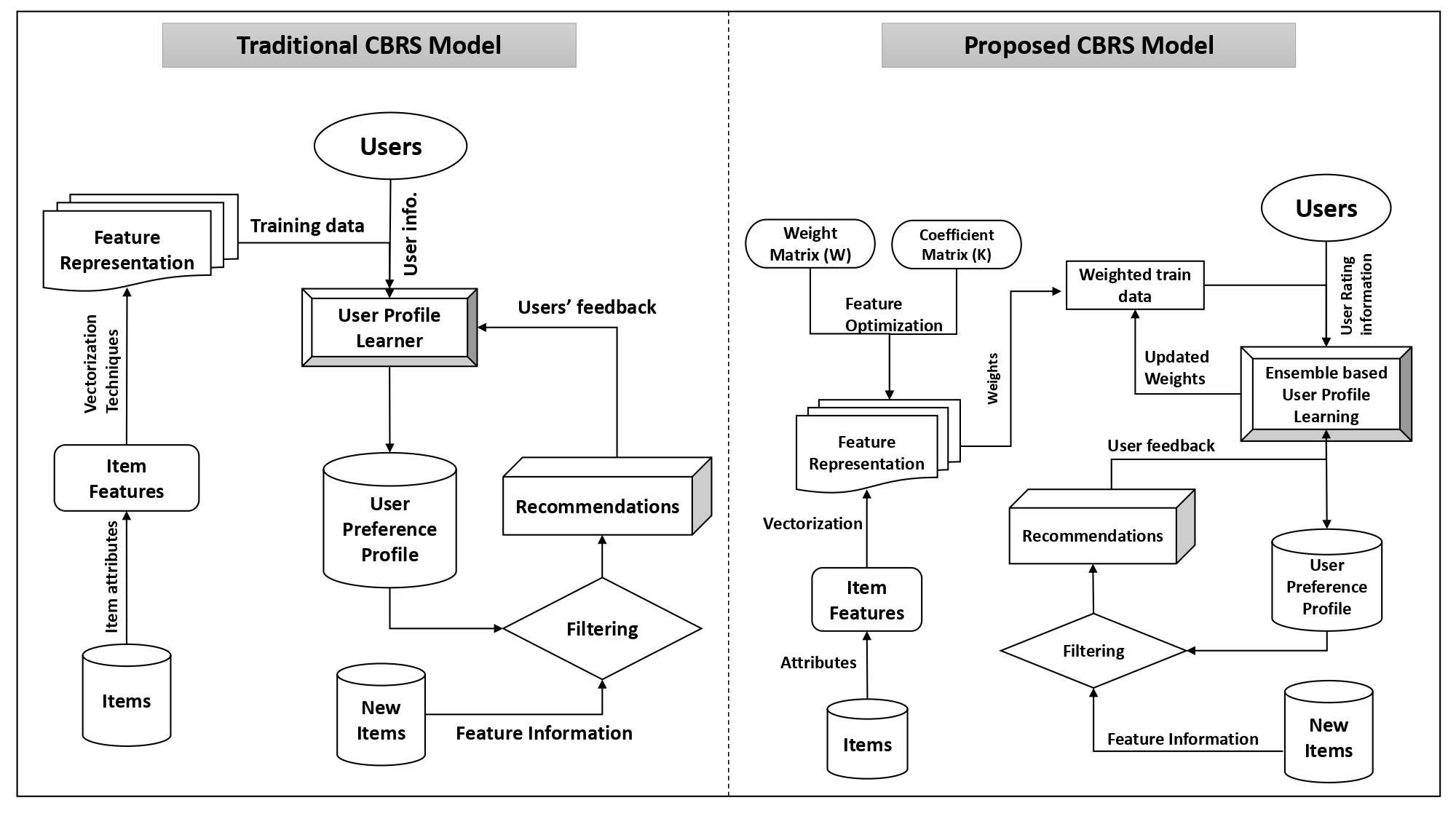
The Department of Computer Science and Engineering is delighted to announce that Dr Abinash Pujahari, Assistant Professor, has published his research article “Item Feature Refinement using Matrix Factorization and Boosted Learning based User Profile Generation for Content-Based Recommender Systems” in the journal Expert Systems with Applications having an Impact Factor of 8.665. The research was done in collaboration with Dr Dilip Singh Sisodia, Assistant Professor, National Institute of Technology Raipur.
This research focuses on improving the quality of information available about the features of various items so that it can be used for content-based recommendations. Content-based recommender systems are used in many e-commerce platforms (e.g., NetFlix, Amazon Prime, etc.). Here, the item (i.e., movies, TV shows) feature information is compared with the users’ past behaviour to recommend similar things. This research enables such systems to study the feature information for more accurate recommendations.
Most of the items’ feature information is sparse, redundant, and inconsistent. Matrix Factorization is used to avoid such inconsistencies. Further, iterative learning of user profiles is used using boosted learning approach for model building. The proposed research is compared with state-of-the-art related works using benchmark datasets and can be implemented in most e-commerce platforms and online streaming service providers. Dr Pujahari looks forwards to employing the same in group recommender systems where individuals have their preferences, in his future research endeavours.
- Published in CSE NEWS, Departmental News, News, Research News
Watermarking medical images for their secure transmission

The Department of Computer Science and Engineering is proud to announce that Dr Priyanka, Assistant Professor, and her research Scholar, Ms Kilari Jyothsna Devi have published their patent (application no: 202241033779 A), “A System and a Method for Watermarking Medical Images for the Secure Transmission of Images”. The patent was published on June 17, 2022, by the Indian Patent Office.
In the present technology, medical images and patient information are widely transmitted through a public transmission channel in e-healthcare applications. While sharing medical images or electronic patient records (EPR) through a public network, they can get tampered with or manipulated, leading to wrong diagnosis by the medical consultants. Similarly, one can easily claim false ownership of the medical images. This makes the confidentiality of the patient record at low cost a major concern.
The proposed novel MIW scheme ensures most of the watermarking characteristics such as high imperceptibility, robustness, security with low computational cost, temper detection and recovery in medical image transmission in real-time healthcare applications. In the future, they intend to design digital image watermarking schemes for the secure transmission of images over blockchain and cloud-based applications.
- Published in CSE NEWS, Departmental News, News, Research News
Two paper presentations at international research conferences
Presenting papers at international research conferences helps hone the research questions. Students from the Department of Computer Science and Engineering have attended two international research conferences and presented their papers drafted under the supervision of Assistant Professor V M Manikandan.
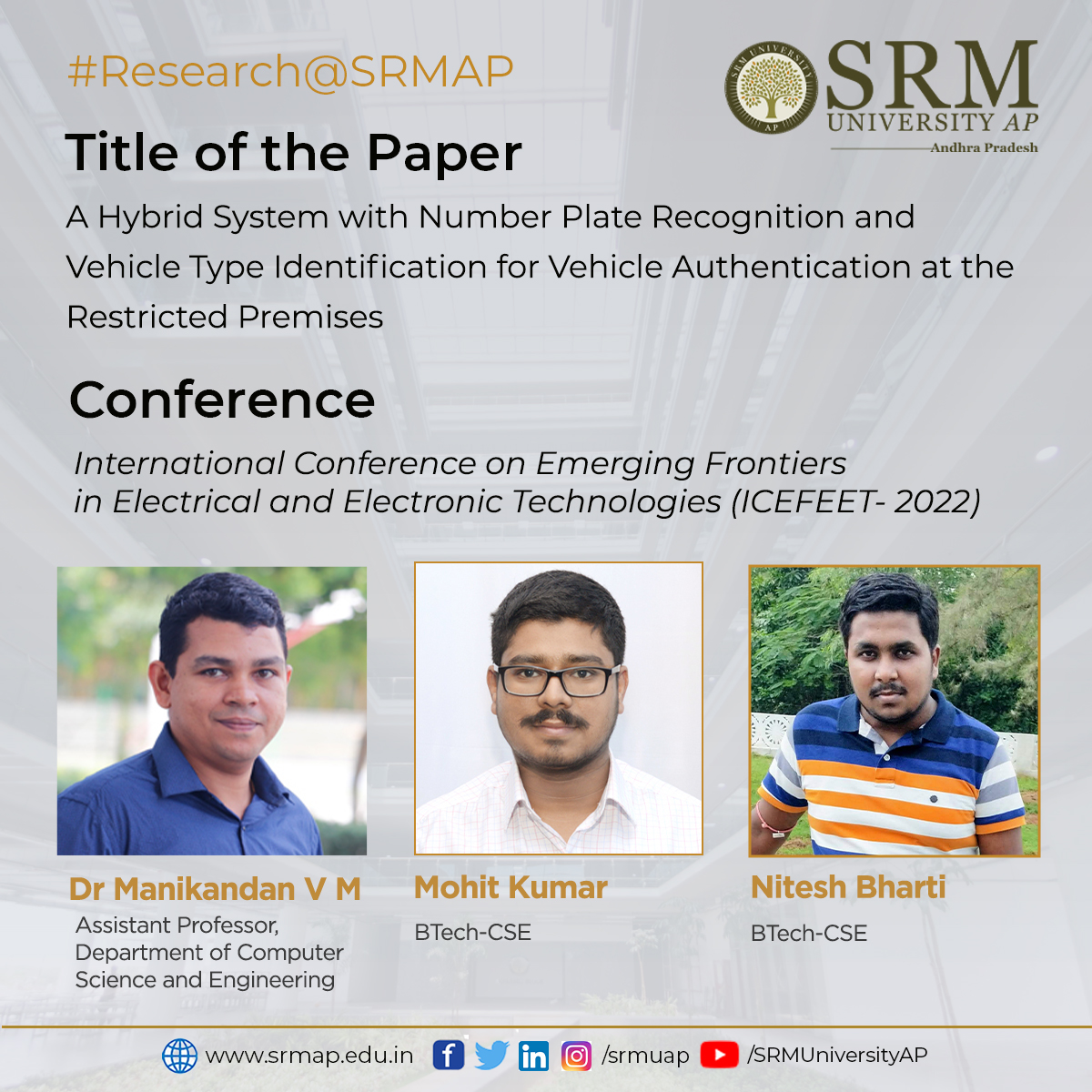 The International Conference on Emerging Frontiers in Electrical and Electronic Technologies (ICEFEET- 2022), organised by NIT Patna, India, was held from June 24 to 25. At the conference, BTech students Nitesh Bharti and Mohit Kumar presented the paper A Hybrid System with Number Plate Recognition and Vehicle Type Identification for Vehicle Authentication at the Restricted Premises. The work was composed under the guidance of Assistant Professor Dr V M Manikandan. The paper will soon be published in IEEE Xplore Digital Library (Scopus indexed). In the future, they plan to integrate the proposed algorithms with proper hardware units to completely automate the authentication of vehicles in restricted areas. The proposed computer vision-based systems can be used in restricted areas to ensure the entry of authenticated vehicles.
The International Conference on Emerging Frontiers in Electrical and Electronic Technologies (ICEFEET- 2022), organised by NIT Patna, India, was held from June 24 to 25. At the conference, BTech students Nitesh Bharti and Mohit Kumar presented the paper A Hybrid System with Number Plate Recognition and Vehicle Type Identification for Vehicle Authentication at the Restricted Premises. The work was composed under the guidance of Assistant Professor Dr V M Manikandan. The paper will soon be published in IEEE Xplore Digital Library (Scopus indexed). In the future, they plan to integrate the proposed algorithms with proper hardware units to completely automate the authentication of vehicles in restricted areas. The proposed computer vision-based systems can be used in restricted areas to ensure the entry of authenticated vehicles.
Explanation of the research
Vehicle detection and number plate recognition approaches have been widely studied in recent years due to their wide applications. The research paper proposes a framework to ensure the entry of authorised vehicles in restricted areas such as University campuses, townships, etc., where the researchers are expecting the entry of a set of authorized vehicles. Certainly, unauthorised vehicles might be allowed to enter those areas after proper verification by the concerned people responsible for ensuring security. In the proposed approach, the admin should register all the authorised vehicles in a system with the essential attributes such as vehicle number, type, etc. A surveillance camera placed at the entrance will capture live videos. When a vehicle is in the camera view, the image frames will be passed to an automatic number plate recognition module. The number plate recognition module will identify the same and be matched with the details in the database to authorise the vehicle. This manuscript proposes a real-time and reliable approach for detecting and recognising license plates based on morphology and template matching. To ensure the system’s reliability, a frame selection module will select the image frames with high quality, and even to improve the number plate recognition accuracy, the image will be enhanced using image enhancement techniques such as histogram equalisation. The image enhancement techniques will help to provide better results even though the videos are taken in low lighting conditions. Further, we ensure that the vehicle type matches the number present in the database to prevent unauthorised access using fake number plates. The experimental study is conducted using videos taken under various environmental conditions such as lighting, slope, distance, and angle.
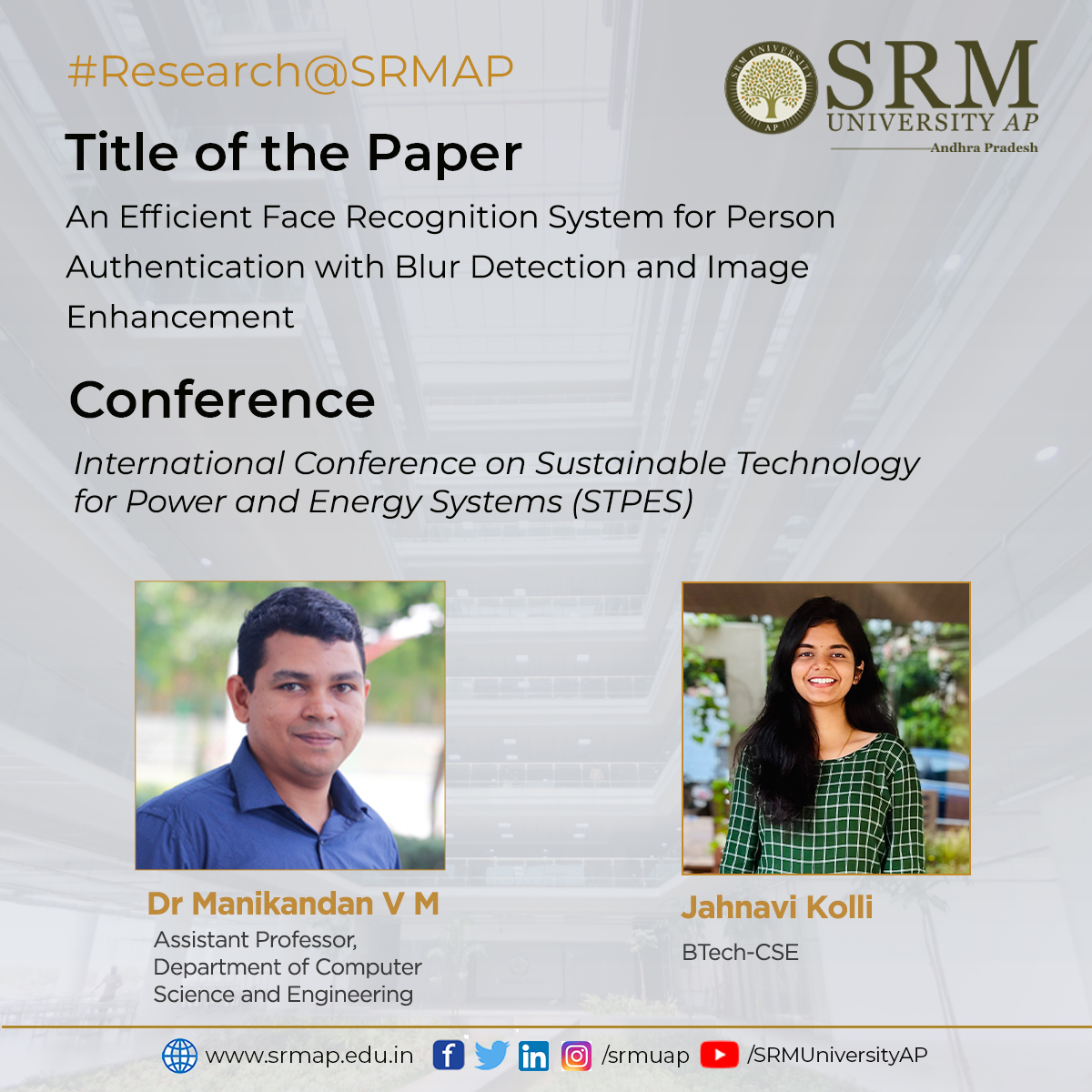 Jahnavi Kolli presented her research paper, An Efficient Face Recognition System for Person Authentication with Blur Detection and Image Enhancement, at the International Conference on Sustainable Technology for Power and Energy Systems (STPES). The conference was organised by NIT Srinagar and IIT Jammu, India, and was held from July 4 to 8, 2022. The research work was monitored by Assistant Professor V M Manikandan and done in collaboration with Professor Yu-Chen Hu, Providence University, Taiwan. The proposed computer face recognition systems can be used to record the attendance of students in class or employees in the office in an easy way. In the future, the researchers plan to improve the face recognition systems, which will perform better when the images are captured using low-resolution cameras or the face regions occluded for some reasons.
Jahnavi Kolli presented her research paper, An Efficient Face Recognition System for Person Authentication with Blur Detection and Image Enhancement, at the International Conference on Sustainable Technology for Power and Energy Systems (STPES). The conference was organised by NIT Srinagar and IIT Jammu, India, and was held from July 4 to 8, 2022. The research work was monitored by Assistant Professor V M Manikandan and done in collaboration with Professor Yu-Chen Hu, Providence University, Taiwan. The proposed computer face recognition systems can be used to record the attendance of students in class or employees in the office in an easy way. In the future, the researchers plan to improve the face recognition systems, which will perform better when the images are captured using low-resolution cameras or the face regions occluded for some reasons.
Explanation of the research
The recent advancements in technology widely help to substitute manpower with machines in a better way. Even though machines are increasingly replacing humans in various ways, there are still a few areas where the use of machines still needs to be explored much more efficiently. Facial recognition systems are one such field. Facial recognition systems are used with various motives, such as identification of suspects in public places, authentication of users on restricted premises, etc. In this work, we propose a facial recognition system to facilitate the authentication of students at the university entrance. The same scheme can also be utilised to authenticate the students before entering examination halls. As the strength of the students at universities increases in a more significant way, it becomes strenuous for the security people to record their attendance manually, which frequently results in erroneous data. This paper proposes a facial recognition system that will help to capture the live videos from an area of interest and identify the faces. Further, a face recognition scheme will detect whether the person is authorised or not. Several facial recognition systems are already available in the literature, and this scheme differs from them in many ways. The proposed method selects the frames with less blur for face detection and further face recognition. A blur detection scheme is used in the proposed system to analyse the amount of blur in the image. To overcome the challenges such as low accuracy during face recognition when the images are taken in low lighting conditions, we use a histogram equalization method to enhance the quality. The experimental study shows that the proposed approach works well in real-time.
- Published in CSE NEWS, Departmental News, News, Research News

